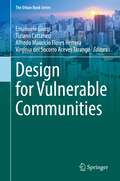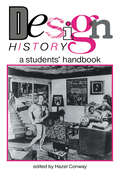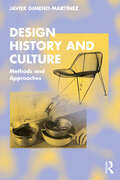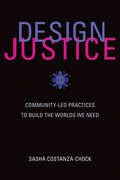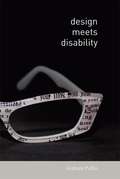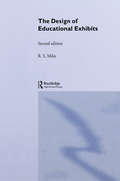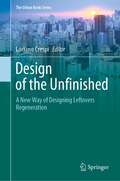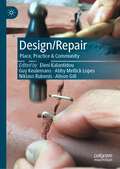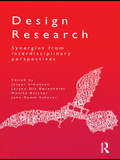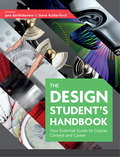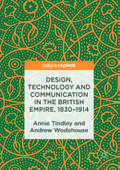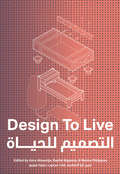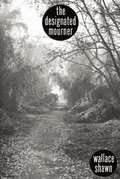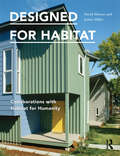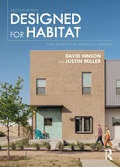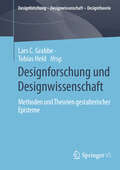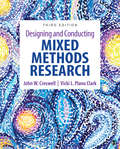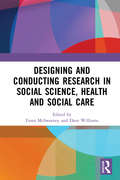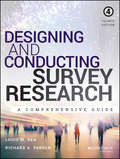- Table View
- List View
Design for Vulnerable Communities (The Urban Book Series)
by Emanuele Giorgi Tiziano Cattaneo Alfredo Mauricio Flores Herrera Virginia del Socorro Aceves TarangoThis book aims to provide bases for reasoning on what challenges urban-architectural design for vulnerable communities will face in the coming years. Several issues, such as technological development, climate change, political crisis and economic uncertainties show as traditional strategies and methodologies are not sufficient to deeply solve the problems of these complex realities. These new changes, which are studied in different fields of knowledge, highlight the fact that the development of effective solutions must be characterized by multidisciplinary approaches and must be based on strategies promoted by different disciplines. For this reason, this contributed volume collects contributions and considerations from experts in various fields of knowledge working in different parts of the world, such as the Americas, Europe and Asia. The goal is precisely to provide the reader with multidisciplinary knowledge and methodologies in order to better reflect and analyze the challenges that designing for vulnerable communities will face in the next few years. These multidisciplinary studies are organized into five sections: Sustainability and Vulnerabilities in Time of the AnthropoceneApproaches, Principles and Paradigms to Contemporary Research and Practice for Vulnerable CommunitiesDesigning for Vulnerabilities: Applications and ActionsSocial Engagement in Vulnerable Communities Between Digital and Humanist VisionsVulnerabilities in Context: Analysis and Projects in the U.S.-Mexico Border RegionDesign for Vulnerable Communities will be of interest primarily to researchers and professionals in the field of urban-architectural design, but it will also be a useful tool to policy makers and members of civil society at large interested in making cities more inclusive.
Design History: A Students' Handbook
by Hazel ConwayHazel Conway introduces the student new to the subject to different areas of design history and shows some of the ways in which it can be studied and some of its delights and difficulties. No background knowledge of design history, art or architecture is assumed.
Design History and Culture: Methods and Approaches
by Javier Gimeno-MartínezThis student-friendly text provides a comprehensive exploration of the methods and approaches employed within design scholarship, drawing upon influences from history, art history, anthropology and interdisciplinary studies such as science and technology studies and material culture studies.Drawing connections between these methods and the evolving landscape of design, the book expands design culture beyond traditional outcomes to encompass areas like design for social innovation, digital design, critical design, design anthropology and craftivism. Additionally, the book introduces novel theoretical frameworks to facilitate discussions on contemporary designers’ work, including new materialism, object-oriented ontology and decolonization.This comprehensive overview of methods and approaches will enable students to select the most appropriate methodological tools for their own research. It is an ideal guide for both undergraduate and postgraduate students in design, design culture, design history, design studies and visual culture.
Design Justice: Community-Led Practices to Build the Worlds We Need (Information Policy)
by Sasha Costanza-ChockAn exploration of how design might be led by marginalized communities, dismantle structural inequality, and advance collective liberation and ecological survival.What is the relationship between design, power, and social justice? “Design justice” is an approach to design that is led by marginalized communities and that aims expilcitly to challenge, rather than reproduce, structural inequalities. It has emerged from a growing community of designers in various fields who work closely with social movements and community-based organizations around the world.This book explores the theory and practice of design justice, demonstrates how universalist design principles and practices erase certain groups of people—specifically, those who are intersectionally disadvantaged or multiply burdened under the matrix of domination (white supremacist heteropatriarchy, ableism, capitalism, and settler colonialism)—and invites readers to “build a better world, a world where many worlds fit; linked worlds of collective liberation and ecological sustainability.” Along the way, the book documents a multitude of real-world community-led design practices, each grounded in a particular social movement. Design Justice goes beyond recent calls for design for good, user-centered design, and employment diversity in the technology and design professions; it connects design to larger struggles for collective liberation and ecological survival.
Design: The Key Concepts (Routledge Key Guides)
by Catherine McDermottThis is the essential student’s guide to Design – its practice, its theory and its history. Drawing from a wide range of international examples, respected design writer Catherine McDermott explores key topics including: international design – from Europe to Africa design history – from Art Nouveau to punk sustainable design, recycling and green design design theory – from semiotics to gender, to postcolonialism design technology, graphic design and the web. Fully cross-referenced, with up-to-date guides for further reading, Design: The Key Concepts is an indispensable reference for students of design, design history, fashion, art and visual culture.
Design Meets Disability
by Graham PullinEyeglasses have been transformed from medical necessity to fashion accessory. This revolution has come about through embracing the design culture of the fashion industry. Why shouldn't design sensibilities also be applied to hearing aids, prosthetic limbs, and communication aids? In return, disability can provoke radical new directions in mainstream design. Charles and Ray Eames's iconic furniture was inspired by a molded plywood leg splint that they designed for injured and disabled servicemen. Designers today could be similarly inspired by disability. In Design Meets Disability, Graham Pullin shows us how design and disability can inspire each other. In the Eameses' work there was a healthy tension between cut-to-the-chase problem solving and more playful explorations. Pullin offers examples of how design can meet disability today. Why, he asks, shouldn't hearing aids be as fashionable as eyewear? What new forms of braille signage might proliferate if designers kept both sighted and visually impaired people in mind? Can simple designs avoid the need for complicated accessibility features? Can such emerging design methods as "experience prototyping" and "critical design" complement clinical trials? Pullin also presents a series of interviews with leading designers about specific disability design projects, including stepstools for people with restricted growth, prosthetic legs (and whether they can be both honest and beautifully designed), and text-to-speech technology with tone of voice. When design meets disability, the diversity of complementary, even contradictory, approaches can enrich each field.
The Design of Digital Democracy (Springer Textbooks in Law)
by Gianluca SgueoEver-stronger ties between technology, entertainment and design are transforming our relationship with democratic decision-making. When we are online, or when we use digital products and services, we tend to focus more on certain factors like speed of service and user-friendliness, and to overlook the costs – both for ourselves and others. As a result, a widening gap separates our expectations of everything related to digitalization – including government – and the actual practice of democratic governance. Democratic regulators, unable to meet citizens’ demands for tangible, fast and gratifying returns, are seeing the poorest results ever recorded in terms of interest, engagement and retention, despite using the most cutting-edge technologies. This book explores various aspects of the relationship between democracy, technology and entertainment. These include, on the one hand, the role that digital technology has in strengthening our collective intelligence, nurturing empathic relations between citizens and democratic institutions, and supporting processes of political aggregation, deliberation and collaboration. On the other hand, they comprise the challenges accompanying digital technology for representation, transparency and inclusivity in democratic decision-making. The book’s main argument is that digital democratic spaces should be redesigned to narrow the gap between the expectations and outcomes of democratic decision-making. It suggests abandoning the notion of digital participatory rights as being fast and easy to enjoy. It also refutes the notion that digital democratic decision-making can only be effective when it delivers rapid and successful responses to the issues of the day, regardless of their complexity. Ultimately, the success or failure of digital democracy will depend on the ability of public regulators to design digital public spaces with a commitment to complexity, so as to make them appealing, but also effective at engaging citizens.
The Design of Educational Exhibits
by M. B. Alt D. C. Gosling Dr R Miles R. S. MilesFirst Published in 1988. Routledge is an imprint of Taylor & Francis, an informa company.
Design of Observational Studies (Springer Series in Statistics)
by Paul R. RosenbaumThis second edition of Design of Observational Studies is both an introduction to statistical inference in observational studies and a detailed discussion of the principles that guide the design of observational studies. An observational study is an empiric investigation of effects caused by treatments when randomized experimentation is unethical or infeasible. Observational studies are common in most fields that study the effects of treatments on people, including medicine, economics, epidemiology, education, psychology, political science and sociology. The quality and strength of evidence provided by an observational study is determined largely by its design. Design of Observational Studies is organized into five parts. Chapters 2, 3, and 5 of Part I cover concisely many of the ideas discussed in Rosenbaum’s Observational Studies (also published by Springer) but in a less technical fashion. Part II discusses the practical aspects of using propensity scores and other tools to create a matched comparison that balances many covariates, and includes an updated chapter on matching in R. In Part III, the concept of design sensitivity is used to appraise the relative ability of competing designs to distinguish treatment effects from biases due to unmeasured covariates. Part IV is new to this edition; it discusses evidence factors and the computerized construction of more than one comparison group. Part V discusses planning the analysis of an observational study, with particular reference to Sir Ronald Fisher’s striking advice for observational studies: "make your theories elaborate." This new edition features updated exploration of causal influence, with four new chapters, a new R package DOS2 designed as a companion for the book, and discussion of several of the latest matching packages for R. In particular, DOS2 allows readers to reproduce many analyses from Design of Observational Studies.
Design of the Unfinished: A New Way of Designing Leftovers Regeneration (The Urban Book Series)
by Luciano CrespiThe book aims to provide city administrators and planners with a tool to accompany them in experimenting with the regeneration of no longer used parts of the built heritage, called leftovers, by adopting an innovative approach. A new and radically different form of project, with the task of proposing a new aesthetic code and a style of thought aimed at creating shelters for nomads of the third millennium.In the design field, the 21st century will be destined to measure itself against temporariness and precariousness, also in terms of aesthetic practices. Based on this hypothesis, the text identifies the design of the unfinished as the perspective for attributing to the leftovers a character, which is representative of the conditions of the just begun century. Through a transdisciplinary, exhibition-like and reversible approach, the elements of degradation of the existing work are welcomed in the project as a "gift", to be translated into a syntax aimed at giving form and meaning to the internal and external environments, with the inclusion of "additional components".
Design/Repair: Place, Practice & Community
by Eleni Kalantidou Guy Keulemans Abby Mellick Lopes Niklavs Rubenis Alison GillThis collection of essays sheds light on repair as a disposition to material culture and a practice rooted in diverse sociocultural experiences. It provides an in-depth exploration of how repair manifests itself through the different lenses of governance, grassroots activism, transformative design and community-led initiatives. Most importantly, the chapters demonstrate how place-based approaches can reveal blueprints for social impact in circumstances of growing environmental and social precariousness.
Design Research: Synergies from Interdisciplinary Perspectives
by Jesper SimonsenDesign Research is a new interdisciplinary research area with a social science orientation at its heart, and this book explores how scientific knowledge can be put into practice in ways that are at once ethical, creative, helpful, and extraordinary in their results. In order to clarify the common aspects – in terms of features and approaches – that characterize all strands of research disciplines addressing design, Design Research undertakes an in-depth exploration of the social processes involved in doing design, as well as analyses of the contexts for design use. The book further elicits ‘synergies from interdisciplinary perspectives’ by discussing and elaborating on differing academic perspectives, theoretical backgrounds, and design concept definitions, and evaluating their unique contribution to a general core of design research. This book is an exciting contribution to this little explored field, and offers a truly interdisciplinary approach to the treatment of design and the design process. It is valuable reading for students in disciplines such as design studies and theory, participatory design, informatics, arts based education, planning, sociology, and interdisciplinary programmes in humanities and technology.
The Design Student's Handbook: Your Essential Guide to Course, Context and Career
by Jane Bartholomew Steve RutherfordWhat is design? What are the main design disciplines, and how do they interrelate? How does design theory and context help you improve your studio work? What do you need to know by the end of your course to get a good career? What can you do to become a knowledgeable designer and improve your skills so that you stand out from the crowd? Whether you are already studying design, thinking about choosing a course, or are well on your way to finding your first job, this essential and uniquely comprehensive book will introduce you to the world of design and support you throughout your studies and on into the industry. Key features Develops your core skills and supports you in making the most of your studies. Describes the multi-disciplinary design world by exploring the various design disciplines – graphics, fashion and textiles, three-dimensional design, craft, spatial, interactive media, and theatre, film and television. Contains crucial practical information so you’re ready for your career - placements, working with industry and self-employment, networking, job-seeking and how to succeed in your own business. Covers the key practical, theoretical and cultural fundamentals of design to help you understand and inform your practice - chapters on creativity and innovation, history, culture and context, how to communicate design, colour theory, aesthetics, and how to design with ethical, social and responsible considerations. Comprises chapters written by designers and lecturers, all experts in their fields. Includes stories, career profiles and first-hand quotes by students, established designers and industry specialists exploring what it’s like to study and to work in the design industry today. Identifies important books and websites for further reading. The Design Student’s Handbook will guide you along the road to a successful and fulfilling career and is an essential text for studying any of the design disciplines.
Design, Technology and Communication in the British Empire, 1830–1914
by Annie Tindley Andrew WodehouseThis book is an innovative, interdisciplinary study of the nature of design as a form of communication within and across Britain and its empire in the long nineteenth century. In this period, Britain had developed from the world's first industrial nation into the 'Workshop of the World' but how were technological innovations translated and communicated across the imperial territories? How were designs turned into reality? This book explores these themes, incorporating archival case study technologies such as trains, sugar manufacture and agricultural technologies. Using a four-part framework we firstly examine the identification of innovation opportunities and how these translated to engineering specifications. The realization of conceptual designs through collaboration and their subsequent manufacture and distribution as finished products are then reviewed. Using the authors' expertise in the fields of historical and design engineering, this study contributes real-world case studies to design theory.
Design Thinking and the New Spirit of Capitalism: Sociological Reflections on Innovation Culture
by Tim SeitzAn ethnographic study on Design Thinking, this book offers profound insights into the popular innovation method, centrally exploring how design thinking’s practice relates to the vast promises surrounding it. Through a close study of a Berlin-based innovation agency, Tim Seitz finds both mundane knowledge practices and promises of transformation. He unpacks the relationships between these discourses and practices and undertakes an exploratory movement that leads him from practice theory to pragmatism. In the course of this movement, Seitz makes design thinking understandable as a phenomenon of what Boltanski and Chiapello described as the “new spirit of capitalism”—that is, an ideological structure that incorporates criticism and therefore strengthens capitalism.
Design to Live: Everyday Inventions from a Refugee Camp
by Azra Aksamija Raafat Majzoub Melina PhilippouThe power of design to create a life worth living even in a refugee camp: designs, inventions, and artworks from the Azraq Refugee Camp in Jordan.This book shows how, even in the most difficult conditions--forced displacement, trauma, and struggle--design can help create a life worth living. Design to Live documents designs, inventions, and artworks created by Syrian refugees living in the Azraq Refugee Camp in Jordan. Through these ingenious and creative innovations--including the vertical garden, an arrangement necessitated by regulations that forbid planting in the ground; a front hall, fashioned to protect privacy; a baby swing made from recycled desks; and a chess set carved from a broomstick--refugees defy the material scarcity, unforgiving desert climate, and cultural isolation of the camp. Written in close collaboration with the residents of the camp, with text in both English and Arabic, Design to Live, reflects two perspectives on the camp: people living and working in Azraq and designers reflecting on humanitarian architecture within the broader field of socially engaged art and design. Architectural drawings, illustrations, photographs, narratives, and stories offer vivid testimony to the imaginative and artful ways that residents alter and reconstruct the standardized humanitarian design of the camp--and provide models that can be replicated elsewhere. The book is the product of a three-year project undertaken by MIT Future Heritage Lab, researchers and students with Syrian refugees at the Azraq Refugee Camp, CARE, Jordan, and the German-Jordanian University. Copublication with Future Heritage Lab, MIT
The Designated Mourner
by Wallace Shawn"The play nicely combines Pinterian menace with caustic political commentary." -Time"Acerbic, elusive, poetic and chilling, the writing is demanding in a rarefied manner. Its implications are both affecting and disturbing." -Los Angeles Times"In his exquisitely written dramatic lament for the decline of high culture. . . . [Shawn] offers a definition of the self that should rattle the defenses of intellectual snobs everywhere." -The New York TimesWriter and performer Wallace Shawn's landmark 1996 play features three characters--a respected poet, his daughter, and her English-professor husband--suspected of subversion in a world where culture has come under the control of the ruling oligarchy. Told through three interwoven monologues, the Orwellian political story is recounted alongside the visceral dissolution of a marriage. The play debuted at the Royal National Theatre in London, in a production directed by David Hare, who also directed the film version, starring Mike Nichols and Miranda Richardson. The play's subsequent New York premiere was staged in a long-abandoned men's club in lower Manhattan, directed by Shawn's longtime collaborator André Gregory.Wallace Shawn is the author of Our Late Night (OBIE Award for Best Play), Marie and Bruce, Aunt Dan and Lemon, The Fever, and the screenplay for My Dinner with André. His most recent play, Grasses of a Thousand Colors, premiered last year in London.
Designed for Habitat: Collaborations with Habitat for Humanity
by David Hinson Justin MillerIf you're looking for ways to give back to your community, then this book, the first to profile thirteen projects designed and built by architects and Habitat for Humanity, will help. Detailed plans, sections, and photographs show you how these projects came about, the strategies used by each team to approach the design and construction process, and the obstacles they overcame to realize a successful outcome. The lessons and insights, presented here will aid you, whether you're an architect, architecture student, Habitat affiliate leader, or an affordable housing advocate. Located all across the United States, these projects represent the full spectrum of Habitat for Humanity affiliates, from large urban affiliates to small rural programs. These cases illustrate a broad range of innovative approaches to energy performance, alternative construction strategies, and responses to site context. And each house demonstrates that design quality need not fall victim to the rigorous imperatives of cost, delivery, and financing.
Designed for Habitat: New Directions for Habitat for Humanity
by David Hinson Justin MillerDesigned for Habitat: New Directions for Habitat for Humanity presents 12 new projects designed and built via collaborations between architects and Habitat for Humanity®. The ways in which we think about affordable housing are being challenged by designers and not-for-profit housing advocates such as Habitat for Humanity and its affiliates. The projects chronicled in this book consider home affordability through the lens of monthly homeownership expenses, energy efficiency and residential energy use, and issues of designed resilience to natural events ranging from aging and accessibility concerns to natural disasters and climate change. New to this edition, the projects reflect new approaches to building scale, construction technology, energy and affordability, and design and context. Illustrated with over 100 color images, the case studies include detailed plans and photographs to show how these projects came about, the strategies used by each team to approach the design and construction process, and the obstacles they overcame to realize a successful outcome. The lessons and insights presented will be a valuable resource, whether you’re an architect, an architecture student, a Habitat affiliate leader, or an affordable housing advocate.
Designforschung und Designwissenschaft: Methoden und Theorien gestalterischer Episteme (Designforschung – Designwissenschaft - Designtheorie)
by Lars C. Grabbe Tobias HeldVon Gestaltung jenseits ästhetischer Traditionslinien zu sprechen, heißt zwangsläufig das moderne Design in den Blick zu nehmen. Zwischen Alltagskultur und Design-Avantgarden bewegen sich vielfältige interdisziplinäre Strömungen, deren theoretische Modelle in Kontextualisierungen und Analysen der Designwissenschaft zusammenlaufen. Hier zeigt sich bereits eine geisteswissenschaftliche Durchdringung und Akzeptanz des Designs als epidemisches Gegenstück zur freien Kunst, wobei diese Meta-Perspektive letztlich eine Forschung „über Design“ darstellt. Design als konkrete Praxis begriffen artikuliert sich jedoch als Relation von Problem, Entwurf und Prototyp, so dass ein handlungstheoretisches Modell einer Forschung „durch Design“ angesetzt werden kann. Designforschung steht damit im Kontrast zur Designwissenschaft, denn sie agiert dynamisch, empirisch und operativ und bündelt zwar Theoriemodelle und konkrete Werkzeuge, lässt diese aber innerhalb konkreter Gestaltungsweisen zu pragmatischen Erkenntnissen werden. Der Band adressiert konkrete Designfelder, arbeitet Aspekte der konkreten und empirischen Designforschung heraus und nimmt gleichzeitig eine Verortung innerhalb der medientheoretischen Bezugsfelder vor. Denn Forschung „durch Design“ geschieht immer durch Medien, Werke, Instrumente und ästhetische Zeichen und Zustände hindurch.
Designing an Internet (Information Policy)
by David D. ClarkWhy the Internet was designed to be the way it is, and how it could be different, now and in the future.How do you design an internet? The architecture of the current Internet is the product of basic design decisions made early in its history. What would an internet look like if it were designed, today, from the ground up? In this book, MIT computer scientist David Clark explains how the Internet is actually put together, what requirements it was designed to meet, and why different design decisions would create different internets. He does not take today's Internet as a given but tries to learn from it, and from alternative proposals for what an internet might be, in order to draw some general conclusions about network architecture. Clark discusses the history of the Internet, and how a range of potentially conflicting requirements—including longevity, security, availability, economic viability, management, and meeting the needs of society—shaped its character. He addresses both the technical aspects of the Internet and its broader social and economic contexts. He describes basic design approaches and explains, in terms accessible to nonspecialists, how networks are designed to carry out their functions. (An appendix offers a more technical discussion of network functions for readers who want the details.) He considers a range of alternative proposals for how to design an internet, examines in detail the key requirements a successful design must meet, and then imagines how to design a future internet from scratch. It's not that we should expect anyone to do this; but, perhaps, by conceiving a better future, we can push toward it.
Designing and Conducting Mixed Methods Research
by John W. Creswell Vicki L. Plano ClarkCombining the latest thinking in the field with practical, step-by-step guidance, the Third Edition of John W. Creswell and Vicki L. Plano Clark’s Designing and Conducting Mixed Methods Research now covers seven mixed methods designs with accompanying journal articles illustrating each design. The authors walk readers through the entire research process, and present updated examples from published mixed methods studies drawn from multiple disciplines. In addition, this new edition includes information about the dynamic and evolving nature of the field of mixed methods research, four additional methodological approaches, and coverage of new directions in mixed methods.
Designing and Conducting Mixed Methods Research
by John W. Creswell Vicki L. Plano ClarkCombining the latest thinking in the field with practical, step-by-step guidance, the Third Edition of John W. Creswell and Vicki L. Plano Clark’s Designing and Conducting Mixed Methods Research now covers seven mixed methods designs with accompanying journal articles illustrating each design. The authors walk readers through the entire research process, and present updated examples from published mixed methods studies drawn from multiple disciplines. In addition, this new edition includes information about the dynamic and evolving nature of the field of mixed methods research, four additional methodological approaches, and coverage of new directions in mixed methods.
Designing and Conducting Research in Social Science, Health and Social Care
by Fiona McSweeney Dave WilliamsThis book presents a novel and accessible way to learn about designing and conducting social research. Unlike traditional social research methods books, it provides a ‘real world’ account of social researchers’ experiences and learning achieved through conducting research in a variety of fields. It contains an eclectic collection of research and advice for conducting research from social researchers with varying backgrounds. Suggestions are made in relation to gaining access to research sites, conducting research on sensitive topics such as suicide, child sexual abuse and homelessness, ensuring the inclusive participation of participants with intellectual disabilities and children. Also included are discussions of conducting practitioner research, conducting research on individual change, psychoanalytically informed research, documentary research and post qualitative research. Other chapters focus on criticality in research on topics that have become politicised and moralised, ensuring that research conducted is credible and how knowledge in research is constructed through both the theoretical framework used and how it is conducted. Bringing together a diverse collection of social research projects, Designing and Conducting Research in Social Science, Health and Social Care will be of interest to students, educators and researchers in the social sciences and professionals in related areas.
Designing and Conducting Survey Research
by Richard A. Parker Louis M. ReaDesigning & Conducting Survey Research, third editionSince it was first published in 1992, Designing and Conducting Survey Research has become the standard reference in the field for public and nonprofit managers who are responsible for conducting effective and meaningful survey research. This updated and expanded third edition builds on the first two volumes and contains additional statistical techniques, new reporting methods that meet the growing demands for accountability, and more user-friendly analysis methods.Designing and Conducting Survey Research is a complete, practical guide to conducting sample survey research. In a comprehensive manner, it explains all major components of survey research, including construction of the instrument, administration of the process, and analysis and reporting of results. Clear, concise, and accessible, this guide explains how to conduct a survey research project from start to finish. Further, it shows how this research method can be applied in such diverse fields as urban affairs, social science, and public administration. Designing and Conducting Survey Research is an excellent tool that will help both professionals and students understand and explain the validity of sample survey research.Praise for the Previous Edition of Designing & Conducting Survey Research"Clear, thorough, well-written, and eminently practical. Takes you step by step through all you need to know to conduct a survey or evaluate one and provides a basic understanding of the theoretical basis of sampling. The clarity of the book makes it a model for effective instruction and one that opens the road for those who must master the subject themselves."-Norton Long, professor emeritus of political science, University of Missouri, St. Louis"A basic tool for conducting survey research projects that any researcher can understand and use. Freed of confusing statistical theory yet comprehensive in approach, with step by step details."-John B. Sauvajot, public management consultant and former deputy chief administrative officer, San Diego County"Demystifies the arcane world of pollsters and survey research. Anyone who conducts surveys, hires survey consultants, reads reports, or makes policy based on survey data will benefit from this book."-Robert J. Waste, Survey Research Center, California State University, Chico
